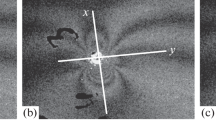Abstract
Residual stress is one of the causes which makes defects in engineering components and materials. These residual stresses can occur in many engineering structures and can sometimes lead to premature failures. There are commonly used methods by which residual stresses are currently measured. But these methods have a little damage and other problems; therefore, a new experimental technique has been devised to measure residual stress in materials with a combination of electronic laser interferometry, laser heating and finite element method. The electronic laser interferometer measures in-plane deformations while the laser heating and cooling provides for very localized stress relief. FEM is used for determining the heat temperature and other parameters. The residual stresses are determined by the amount of strain that is measured subsequent to the heat-up and cool-down of the region being interrogated. A simple model is presented to provide a description of the method. In this paper, the ambiguity problem for the fringe patterns has solved by a phase shifting method.
Similar content being viewed by others
References
Butters, J. N. and Leendertz, J. A. 1971, “Speckle Pattern and Holographic Techniques in Engineering Metrology,”Optics and Laser Technology, Vol. 3, No. 27.
Cook, R. D., Malkus, D. S. and Plesha, M. E., 1989, “Concepts and Application of Finite Element Analysis,”John Wiley & Sons, Inc., New York.
Jones, R. and Wykes, C., 1989, “Holographic and Speckle Interferometry, 2nd ed.”,Cambridge Univ. Press, pp. 146–182.
Kang, Y. J. and Kim, K. S., 1999, “Experimental Analysis of Vibration Modes of Plates Using ESPI,”KSME International Journal, Vol. 13, No. 10, pp. 677–686.
Nickola, W. E., 1984, “Weld Induced Residual Stress Measurements Via the Hole-Drilling Strain Gauge Method,”American Society of Mechanical Engineering, Report 84-WA/DE-25.
Pechersky, M. J., Miller, R. F. and Vikram, C. S., 1995, “Residual Stress Measurements with Laser Speckle Correlation Interferometry and Local Heat Treating,”Optical Engineering, Vol. 34, No. 10, pp. 2964–2971.
Rastogi, P. K., 1994, “Holographic Interferometry,”Springer Series in Optical Sciences, pp. 27–31.
Stanley, R. K., Moore, P. O. and Malntire, P., 1995, “Nondestructive Testing Handbook,”ASNT, Vol. 9, pp. 2–13.
Swanson Analysis Systems, Inc. 1993, “ANSYS Solid Modeling User Guide for Reversion 5.0.”
Swanson Analysis Systems, Inc. 1993. “ANSYS Verification for Reversion 5.0.”
Swanson Analysis Systems, Inc. 1993, “ANSYS Heat Transfer User Guide for Reversion 5.0.”
Author information
Authors and Affiliations
Corresponding author
Rights and permissions
About this article
Cite this article
Kim, KS., Kang, YJ., Rho, KW. et al. The electronic laser interferometry and laser heating method for residual stress determination. KSME International Journal 14, 715–721 (2000). https://doi.org/10.1007/BF03184456
Received:
Revised:
Issue Date:
DOI: https://doi.org/10.1007/BF03184456




